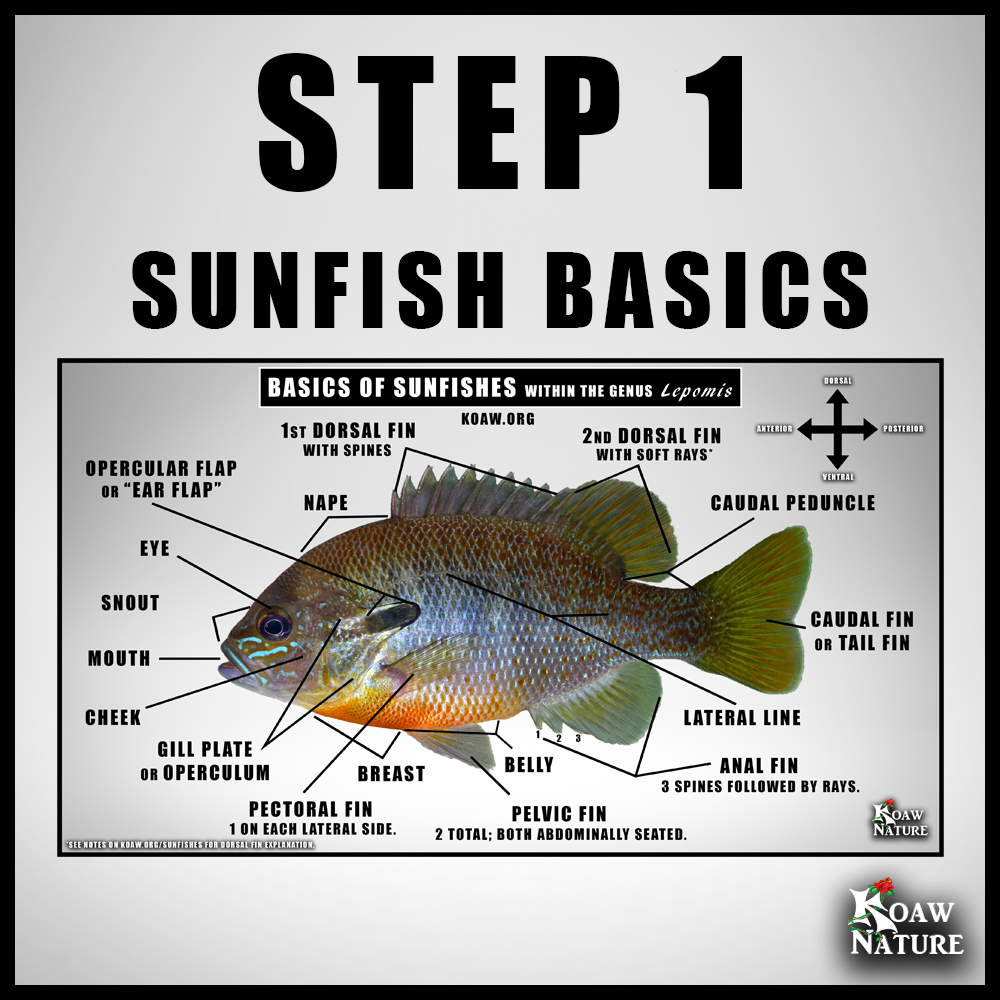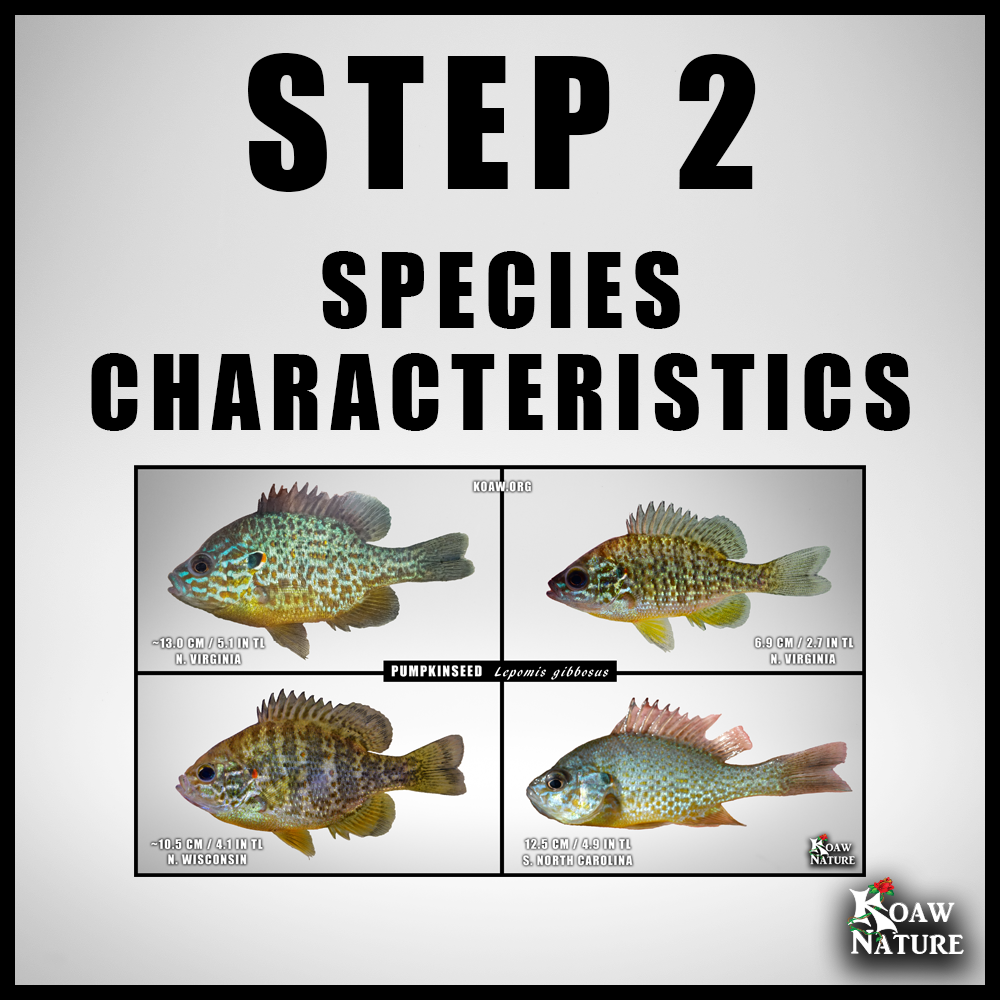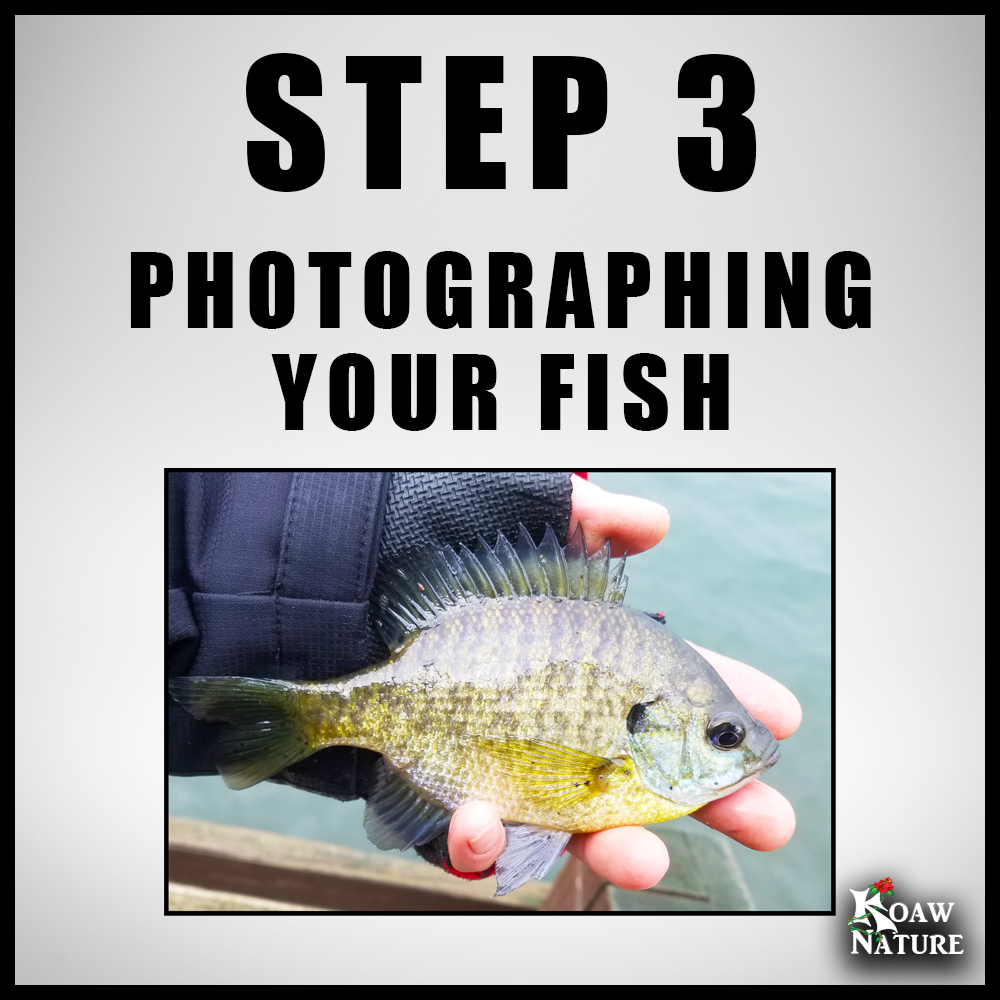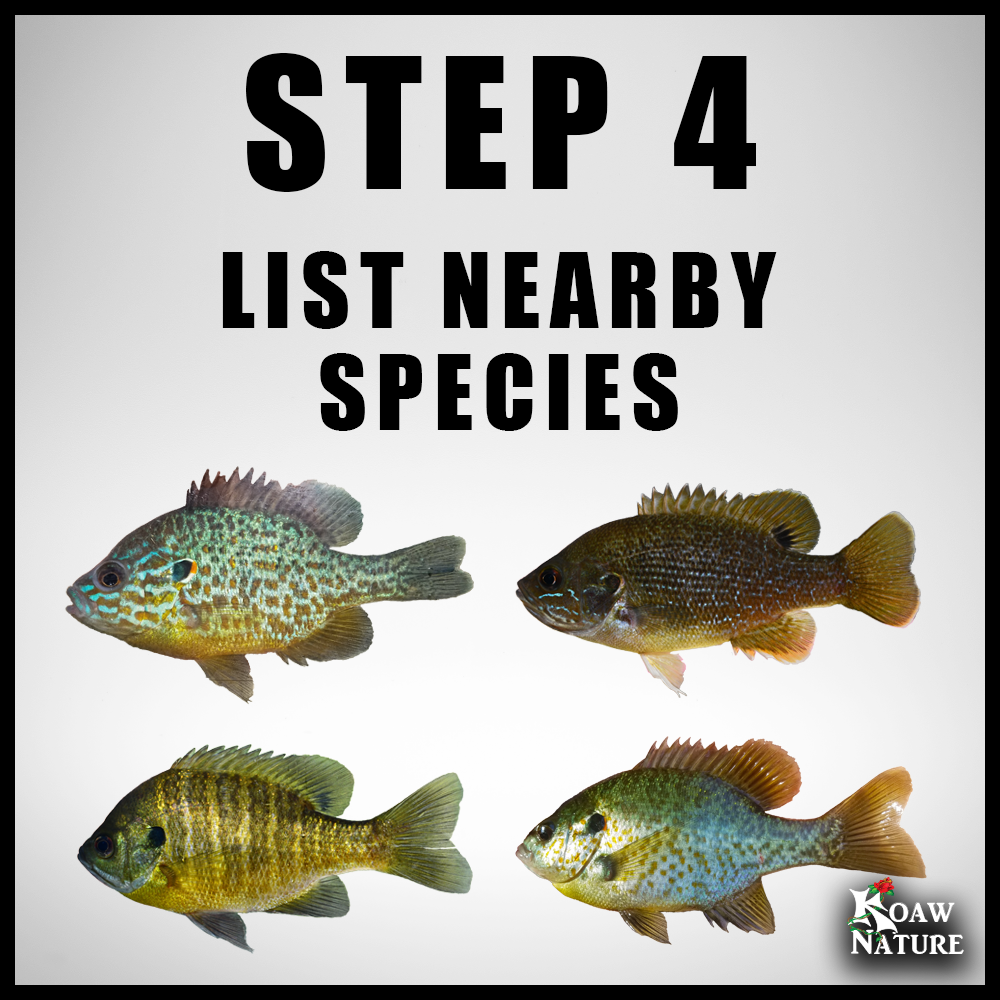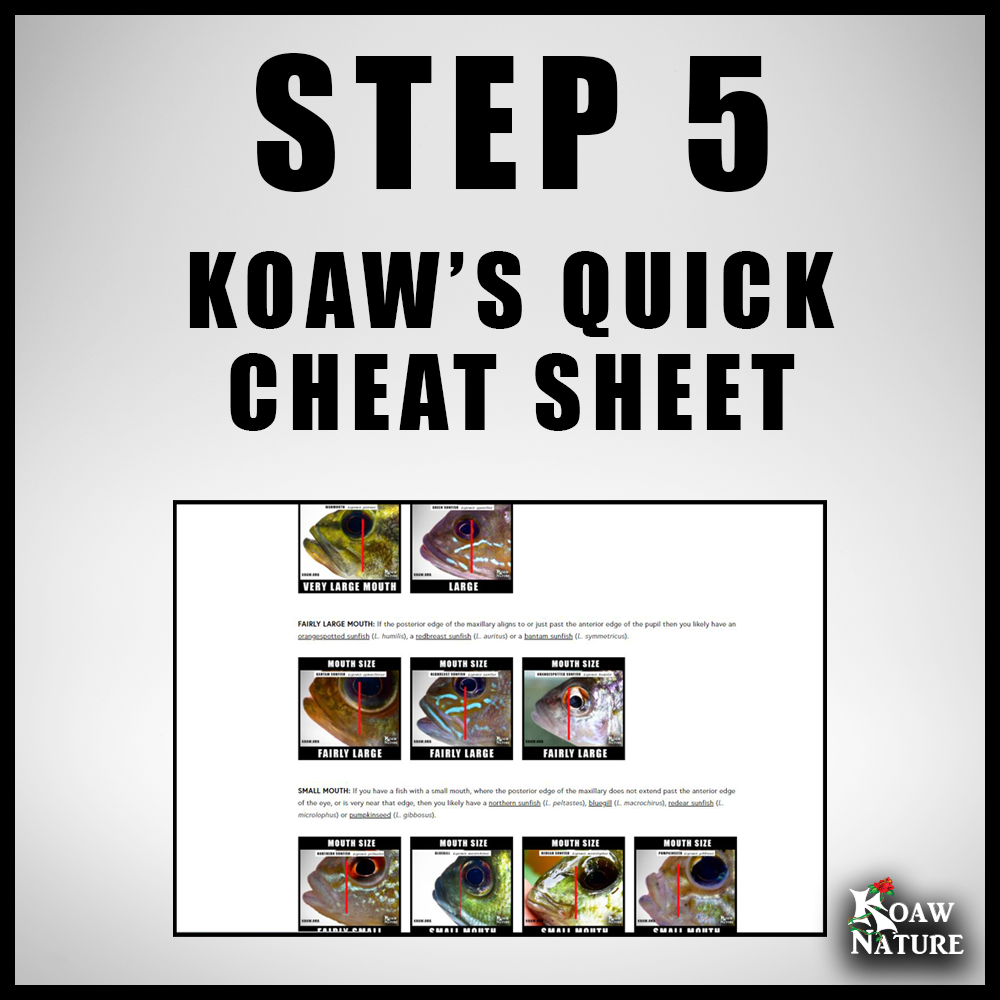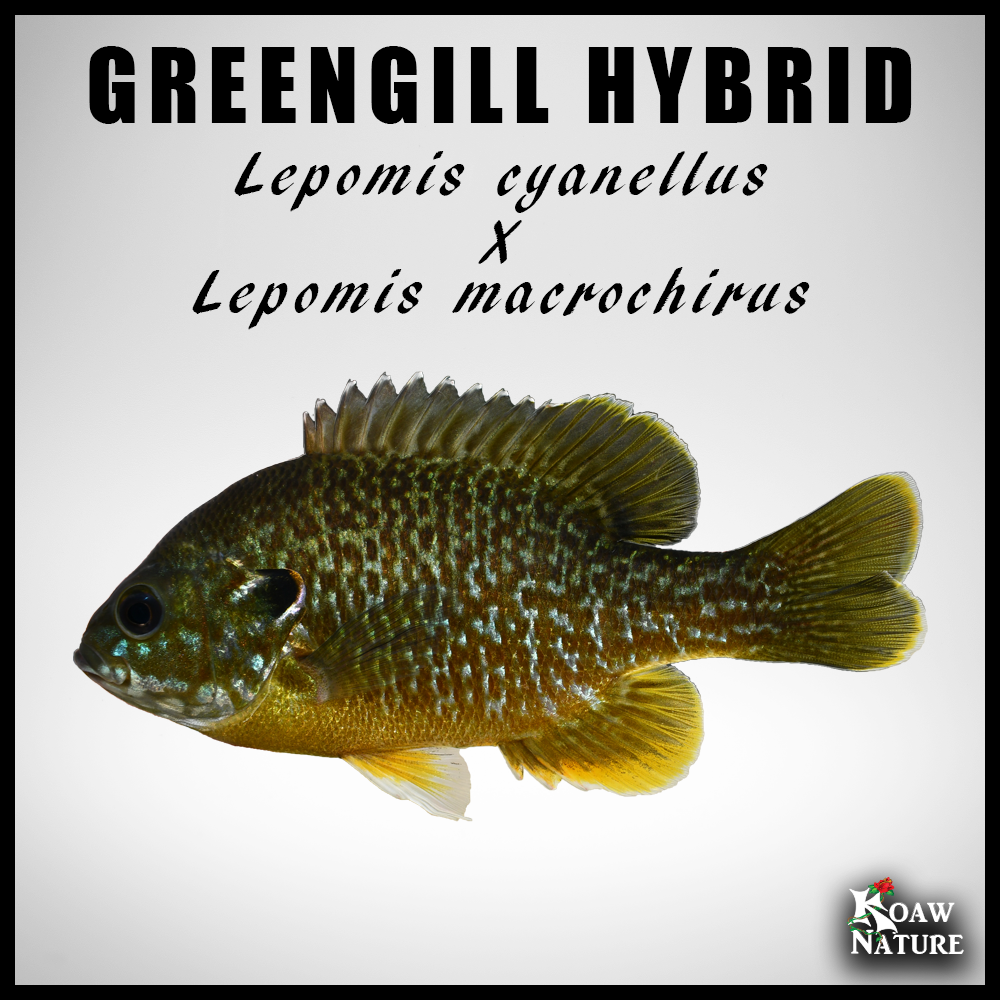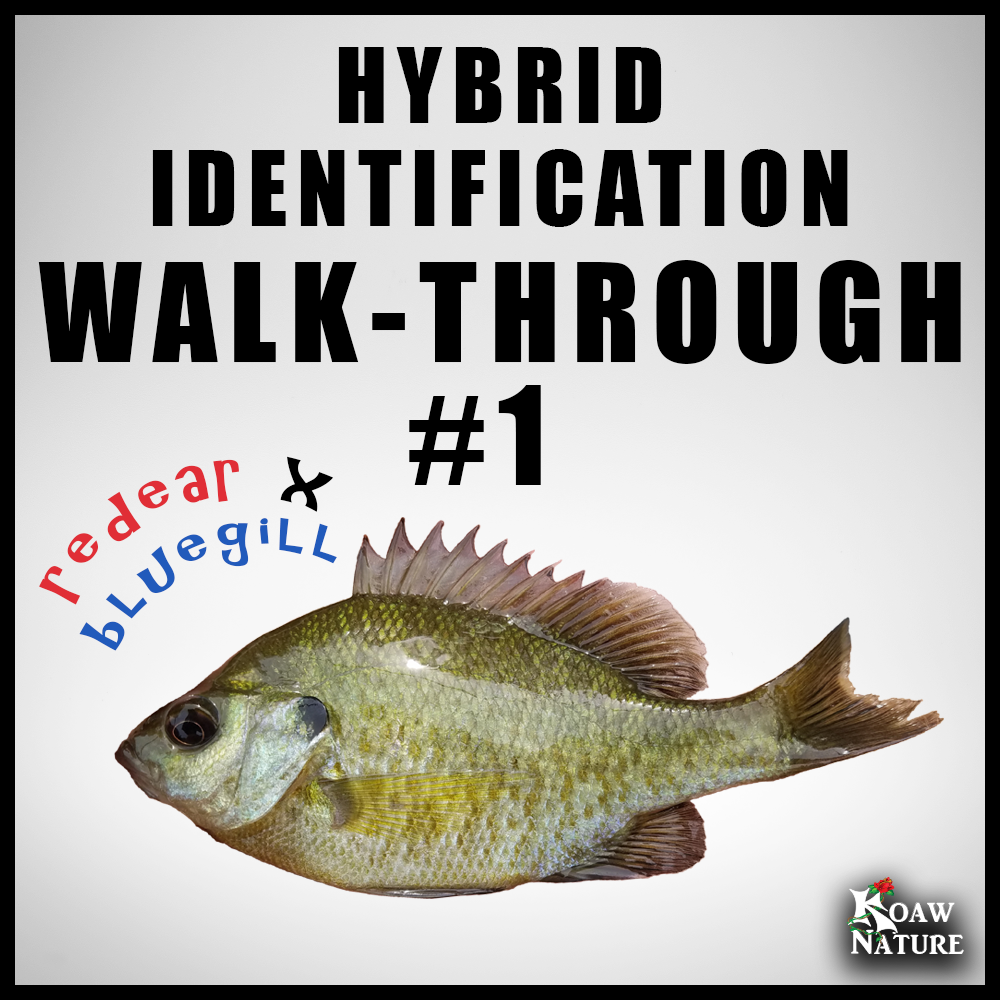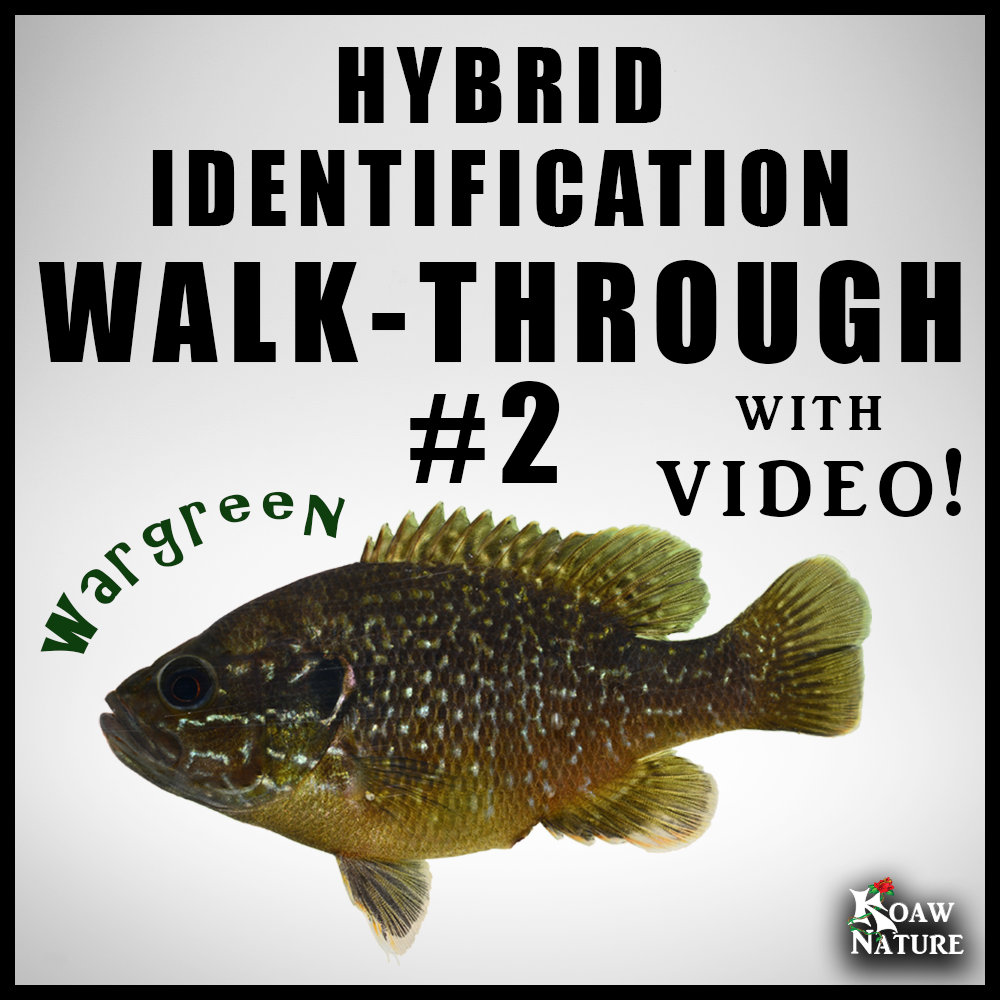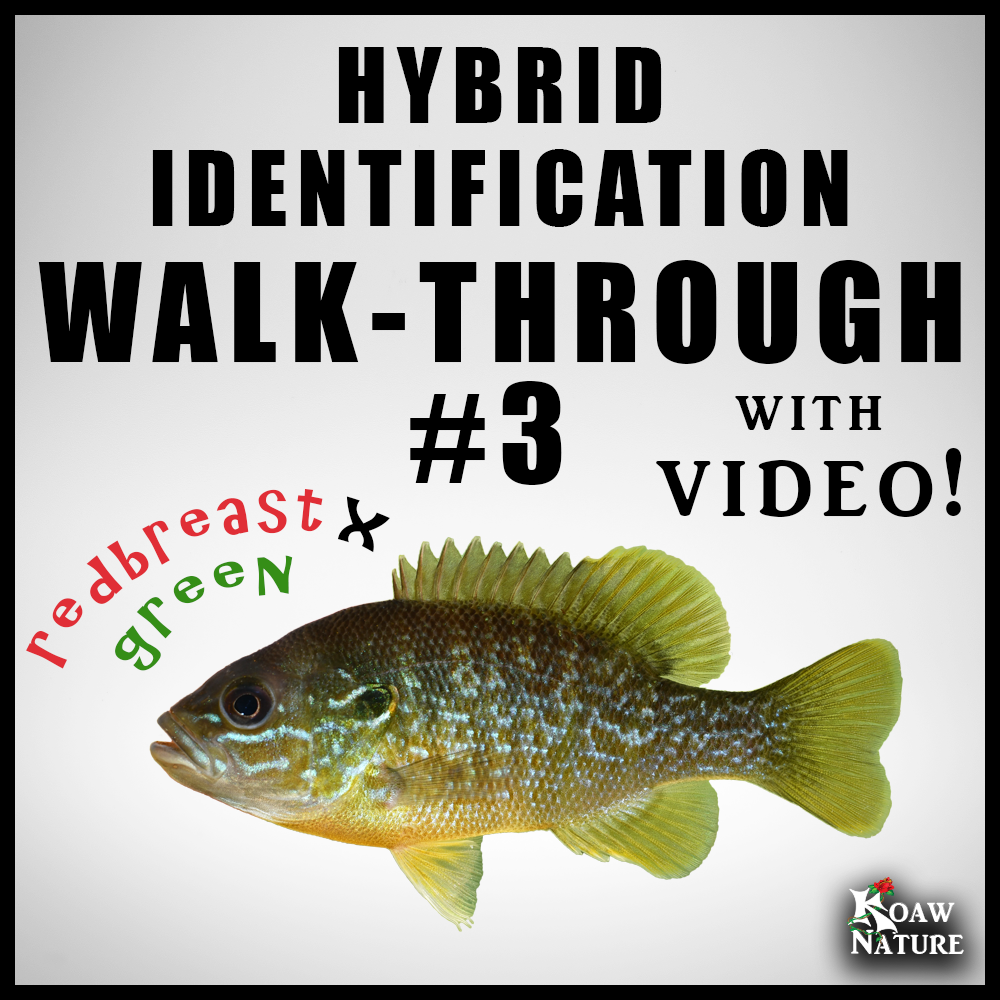By Koaw - November, 2020 - Updated, 2023
INTRODUCTION TO HYBRIDS:
All 13 currently recognized sunfishes within the genus Lepomis are theoretically capable of hybridizing with one another, producing a possible 78 combinations*; C(n,r) = n!/(r!(n-r!)) At least 22 crosses have been found in nature and crosses in artificial settings have produced more variants of intrageneric (within genus) hybridizations as well as successful intergeneric (between genera) crosses with species within Pomoxis (crappies) and Micropterus (black basses). [1-4]
Hybridizations among fishes is not a commonality in the wild. By the year 1957 only 167 naturally occurring hybridizations between fishes were known worldwide, most were between freshwater fishes in North America. [5] [6] More natural hybridizations have been discovered since then, however, of the 35,000+ described fishes in the world, [7] interspecific hybridizations between fishes remains very uncommon. The lepomids are a fascinating exception to the trend, where although interspecific hybridizations in nature occur at a low frequency, that frequency of occurrence, as well as the production of offspring capable of surviving to maturity, is noticeably higher in Lepomis relative to most other groups of fishes. [6] [1]
Perhaps the most often encountered lepomid hybrid is the greengill, both naturally and what is cultivated in aquaculture. [8] [9] The term “greengill” is the common name given to the crossing of a bluegill (Lepomis macrochirus) and a green sunfish (Lepomis cyanellus). The two aforementioned species are the most ubiquitous sunfishes in North America, found across the U.S. as well as in places in Canada and Mexico. [10-13] None of the other lepomid hybrids have convenient names like “greengill” thus the naming format of hybrids will typically be seen as bluegill x green sunfish (L. macrochirus x L. cyanellus). (And FYI, bluegill and green sunfish may not be capitalized in some textual situations depending on the rules being followed. I adhere to the International Commission of Zoological Nomenclature (ICZN) across this site. Though as of 2013, the American Fisheries Society now requests publication submissions to capitalize common names of fishes in English, with exceptions. [14] See my read on binomial nomenclature if you want to learn more.)
WHY IDENTIFYING HYBRIDS IS DIFFICULT:
Identifying lepomid hybrids in the field is no simple task. In actuality, identification first requires an “intimate knowledge of the variation in form and pattern within each species.” That logic was given to me by Fisheries Biologist Bob Jacobs, an expert of North American ichthyofauna who has authored fish identification field guides and also worked extensively with lepomids and their hybrids.
Each individual species within Lepomis will have varying appearances within and between populations, just as humans have varying appearances in the same. A potential identifier must be able to discern what combination of characteristics qualify as sufficiently atypical from normal variance to consider a specimen a hybrid.
Body pattern on a greengill.
Once this “intimate knowledge” is acquired, identification becomes rather obvious for determining if a specimen is a hybrid or at least had experienced introgression in its lineage (genetic swapping); hybrids often have “confused” patterns and colors and oddly shaped bodies. [15] The true difficulty is ascertaining the parent species, whether or not the specimen is an F1 or F2 hybrid (first or second generation) or perhaps a specimen of backcrossing.
Although backcrossing and F2 hybrids have proven possible in artificial settings, the probability of encountering a wild F2 hybrid or a backcrossed specimen is extremely unlikely. Though hybrids are fertile in many instances, reduced gonads exist in hybrids that produce deformed gametes (eggs & sperm) in lesser number compared to the parent species. [1] [6] Also many psychological and physiological barriers exist within Lepomids that restrict species from mating outside the species, [16] [17] likely reducing a hybrid’s ability, with atypical characteristics, to find mating opportunities.
Experts and scientists who deal with wild lepomid hybrids are often unable to confidently identify the parent species just from gathering morphological data, instead depending on DNA analyses to ascertain a better understanding of the hybridization, of which, may still offer inconclusive results! [18] [19]
Many factors may change the phenotypic expression (appearance) of an individual fish or individuals of an entire population, factors that do not even involve hybridizations or past introgressions. Varying environmental conditions such as ecological niche availability, consumed diet, competition with other fishes, and water quality may alter the appearances of individuals as well as populations. [20-22] Sexual dimorphism exists to varying degrees within every lepomid species where males and females take on different characteristics, especially during breeding seasons. Male lepomids tend to express much brighter colors and elaborate patterns than females during breeding seasons. [23] Male hybrids in breeding colors may produce some of the strangest colorations and patterns.
Not only is there great intraspecific phenotypic variation within sunfishes, or differences in appearances within separate and individual populations of the same species, but as Bob Jacobs also mentioned, “…when (lepomids) hybridize, their DNA gets shuffled like two dissimilar decks of cards.” And although most hybridizations will result in intermediary characteristics between the parent species, [6][24][19][25] or characteristics that seem like a fairly even mix of each parent’s genetic contribution, this intermediacy is not uniform and still produces peculiar features.
Essentially, it is often impractical to make a confident identification on a hybrid sunfish without having either controlled and/or fully understood the parent species involved during a hybridization event or submitting a specimen to a DNA analysis.
Alas, that may seem a bit unsatisfactory if you are hoping to get an accurate identification without a DNA analysis. There are steps that can be followed to at least point you in the right direction towards identifying your fish and narrowing down the possibilities. Some hybrids are actually very obvious, especially when a green sunfish is involved. At the very least, you may take some solace in knowing that even experts often run into difficulties trying to field-ID hybrids, I know I do at times.
If you want to become more adept at identifying hybrids then check out the content linked below. I have created a six-step tutorial for identifying sunfishes—start there. Again, you must first gain the knowledge of what individual species look like before gaining the ability to discern the appearances of hybrids.
Once those steps are mastered, check out the individual hybrid pages as well as the walkthroughs where I will discuss how some hybrids can be identified with good confidence from morphological features.
STEPS FOR IDENTIFICATION:
EXTRA HYBRID PAGES
*Although 78 combinations are possible from 13 parent species there are technically 156 possible combinations if considering different sex parents for each species cross. In artificial crossings of hybrids, it has been shown that hatching rates and survivorship may vary tremendously just by switching the parents of the same species-type cross. E.g. – Childlers (1967) found that crossing male warmouth (L. gulosus) with female bluegill (L. macrochirus) was 100% lethal. But when the warmouth parent was female, successful F1 and even F2 generations were raised. [1] Other crosses have also been shown to be completely lethal or partially lethal in artificial settings.
REFERENCES:
W. F. Childlers, "Hybridization of Four Species of Sunfishes (Centrarchidae)," Bull. Ill. Nat. Hist. Surv., vol. 29, no. 3, 1967.
M. L. Warren, Jr., "Variation of the Spotted Sunfish, Lepomis punctatus Complex (Centrarehidae): Meristies, Morphometries, Pigmentation and Species Limits," Bull. Alabama Mus. Nat. Hist., vol. 12, pp. 1-47, 1991.
J. L. West and E. F. Hester, "Intergeneric Hybridization of Centrarchids," Transactions of the American Fisheries Society, vol. 95, no. 3, pp. 280-288, 1966.
H. R. Parker, D. P. Philipp and G. S. Whitt, "Gene Regulatory Divergence among Species Estimated by Altered Developmental Patterns in Interspecific Hybrids," Mol. Biol. Evol. , vol. 2, no. 3, pp. 217-250, 1985.
E. P. Slastenenko, "A list of natural fish hybrids of the world.," Hydrogiological Research Institute, vol. 4, no. 2-3, pp. 76-97, 1957.
C. L. Hubbs, "Hybridization between Fish Species in Nature," Systematic Zoology, vol. 4, no. 1, pp. 1-20, 1955.
R. Fricke, W. N. Eschmeyer and R. van der Laan, "ESCHMEYER'S CATALOG OF FISHES: GENERA, SPECIES, REFERENCES," [Online]. Available: http://researcharchive.calacademy.org/research/ichthyology/catalog/fishcatmain.asp. [Accessed 19 August 2020].
C. C. Mischke, J. E. Morris and R. L. Lane, "Species Profile: Hybrid Sunfish," Southern Regional Aquaculture Center, no. Pub. #7205, 2007.
J. D. O'Donnell, "Annotated List of the Fishes of Illinois," Illinois Natural History Survey Bulletin, vol. 20, no. 5, pp. 473-491, 1935.
USGS - NAS, "Lepomis cyanellus," [Online]. Available: https://nas.er.usgs.gov/queries/SpeciesAnimatedMap.aspx?SpeciesID=380. [Accessed 2020].
USGS, "USGS-NAS Lepomis macrochirus," [Online]. Available: https://nas.er.usgs.gov/queries/FactSheet.aspx?SpeciesID=385. [Accessed 2020 August].
iNaturalist, "Green Sunfish - Lepomis cyanellus," [Online]. Available: https://www.inaturalist.org/taxa/58636-Lepomis-cyanellus. [Accessed 2020].
iNaturalist, "Lepomis macrochirus Bluegill," iNaturalist, 2020. [Online]. Available: https://www.inaturalist.org/taxa/49591-Lepomis-macrochirus. [Accessed August 2020].
M. L. Page, H. Espinosa-Pérez, L. T. Findley, C. R. Gilbert, N. R. Lea, N. E. Mandrak and R. L. Mayden, Common and scientific names of fishes from the United States, Canada, and Mexico. Seventh Edition., vol. 34, American Fisheries Society, 2013, pp. I + xii + 1-384.
R. P. Jacobs and E. B. O'Donnell, "Sunfishes and Freshwater Basses," in Freshwater Fishes of Connecticut, Hartford, Connecticut Dept. of Environmental Protection, 2009, pp. 164-180.
J. W. Gerald, "Sound Production During Courtship in Six Species of Sunfish (Centrarchidae)," Evolution, vol. 25, no. 1, pp. 75-87, 1971.
M. R. Gross, "Sneakers, satellites, and parentals: polymorphic mating strategies in North American sunfishes.," Zeitschrift für Tierpsychologie, vol. 60, pp. 1-26, 1982.
J. C. Avise and N. C. Saunders, "Hybridization and Introgression Among Species of Sunfish (Lepomis): Analysis by Mitochondrial DNA and Allozyme Markers," Genetics, vol. 108, pp. 237-255, 1984.
N. A. Neff and G. R. Smith, "Multivariate Analysis of Hybrid Fishes," Systematic Zoology, vol. 28, no. 2, pp. 176-196, 1979.
S. Hegrenes, "Diet-induced phenotypic plasticity of feeding morphology in the orangespotted sunfish, Lepomis humilis," Ecology of Freshwater Fish, vol. 10, pp. 35-42, 2001.
C. J. Jastrebski and B. W. Robinson, "Natural selection and the evolution of replicated trophic polymorphisms in pumpkinseed sunfish (Lepomis gibbosus)," Evolutionary Ecology Research, vol. 6, pp. 285-305, 2004.
S. Ağdamar, A. S. Tarkan, E. Keskin, N. Top, E. Doğac, Ö. Baysal and Ö. Emiroğlu, "The role of environmental factors and genetic diversity on colonization success of non-native fish, Lepmis gibbosus from western part of Turkey," Biochemical Sciences and Ecology, vol. 58, pp. 195-203, 2015.
L. M. Page and B. M. Burr, Peterson Field Guide to Freshwater Fishes, Houghton Mifflin Harcourt Publishing Company, 2011.
R. S. Birdsong and R. W. Yerger, "A Natural Population of Hybrid Sunfishes: Lepomis macrochirus × Chaenobryttus gulosus," American Society of Ichthyologists and Herpetologists ASIH, vol. 1967, no. 1, pp. 62-71, 1967.
D. A. Etnier, "Reproductive Success of Natural Populations of Hybrid Sunfish in Three Minnesota Lakes," Transactions of the American Fisheries Society, vol. 97, no. 4, pp. 466-471, 2011.
